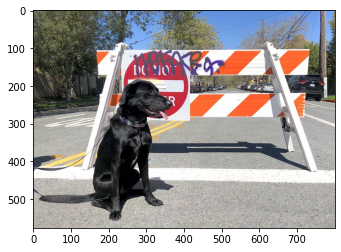Convert a TensorFlow Model to OpenVINO¶
This short tutorial shows how to convert a TensorFlow MobileNetV3 image classification model to OpenVINO’s Intermediate Representation (IR) format using the Model Optimizer tool. After creating the IR, we load the model in OpenVINO’s Inference Engine and perform inference with a sample image.
Imports¶
import time
from pathlib import Path
import cv2
import matplotlib.pyplot as plt
import numpy as np
from IPython.display import Markdown
from openvino.runtime import Core
Settings¶
# The paths of the source and converted models
model_path = Path("model/v3-small_224_1.0_float.pb")
ir_path = Path(model_path).with_suffix(".xml")
Convert the Model to OpenVINO IR Format¶
Convert TensorFlow Model to OpenVINO IR Format¶
Call the OpenVINO Model Optimizer tool to convert the TensorFlow model
to OpenVINO IR with FP16 precision. The models are saved to the current
directory. We add the mean values to the model and scale the output with
the standard deviation with --scale_values. With these options, it
is not necessary to normalize input data before propagating it through
the network. The original model expects input images in RGB format. The
converted model also expects images in RGB format. If you want the
converted model to work with BGR images, you can use the
--reverse-input-channels option. See the Model Optimizer Developer
Guide
for more information about Model Optimizer, including a description of
the command line options. Check the model
documentation
for information about the model, including input shape, expected color
order and mean values.
We first construct the command for Model Optimizer, and then execute
this command in the notebook by prepending the command with a !.
There may be some errors or warnings in the output. Model Optimization
was succesful if the last lines of the output include
[ SUCCESS ] Generated IR version 11 model.
# Construct the command for Model Optimizer
mo_command = f"""mo
--input_model "{model_path}"
--input_shape "[1,224,224,3]"
--mean_values="[127.5,127.5,127.5]"
--scale_values="[127.5]"
--data_type FP16
--output_dir "{model_path.parent}"
"""
mo_command = " ".join(mo_command.split())
print("Model Optimizer command to convert TensorFlow to OpenVINO:")
display(Markdown(f"`{mo_command}`"))
Model Optimizer command to convert TensorFlow to OpenVINO:
mo --input_model "model/v3-small_224_1.0_float.pb" --input_shape "[1,224,224,3]" --mean_values="[127.5,127.5,127.5]" --scale_values="[127.5]" --data_type FP16 --output_dir "model"
# Run Model Optimizer if the IR model file does not exist
if not ir_path.exists():
print("Exporting TensorFlow model to IR... This may take a few minutes.")
! $mo_command
else:
print(f"IR model {ir_path} already exists.")
Exporting TensorFlow model to IR... This may take a few minutes.
Model Optimizer arguments:
Common parameters:
- Path to the Input Model: /home/runner/work/openvino_notebooks/openvino_notebooks/notebooks/101-tensorflow-to-openvino/model/v3-small_224_1.0_float.pb
- Path for generated IR: /home/runner/work/openvino_notebooks/openvino_notebooks/notebooks/101-tensorflow-to-openvino/model
- IR output name: v3-small_224_1.0_float
- Log level: ERROR
- Batch: Not specified, inherited from the model
- Input layers: Not specified, inherited from the model
- Output layers: Not specified, inherited from the model
- Input shapes: [1,224,224,3]
- Source layout: Not specified
- Target layout: Not specified
- Layout: Not specified
- Mean values: [127.5,127.5,127.5]
- Scale values: [127.5]
- Scale factor: Not specified
- Precision of IR: FP16
- Enable fusing: True
- User transformations: Not specified
- Reverse input channels: False
- Enable IR generation for fixed input shape: False
- Use the transformations config file: None
Advanced parameters:
- Force the usage of legacy Frontend of Model Optimizer for model conversion into IR: False
- Force the usage of new Frontend of Model Optimizer for model conversion into IR: False
TensorFlow specific parameters:
- Input model in text protobuf format: False
- Path to model dump for TensorBoard: None
- List of shared libraries with TensorFlow custom layers implementation: None
- Update the configuration file with input/output node names: None
- Use configuration file used to generate the model with Object Detection API: None
- Use the config file: None
OpenVINO runtime found in: /opt/hostedtoolcache/Python/3.8.12/x64/lib/python3.8/site-packages/openvino
OpenVINO runtime version: 2022.1.0-7019-cdb9bec7210-releases/2022/1
Model Optimizer version: 2022.1.0-7019-cdb9bec7210-releases/2022/1
/opt/hostedtoolcache/Python/3.8.12/x64/lib/python3.8/site-packages/numpy/lib/function_base.py:792: VisibleDeprecationWarning: Creating an ndarray from ragged nested sequences (which is a list-or-tuple of lists-or-tuples-or ndarrays with different lengths or shapes) is deprecated. If you meant to do this, you must specify 'dtype=object' when creating the ndarray
return array(a, order=order, subok=subok, copy=True)
[ SUCCESS ] Generated IR version 11 model.
[ SUCCESS ] XML file: /home/runner/work/openvino_notebooks/openvino_notebooks/notebooks/101-tensorflow-to-openvino/model/v3-small_224_1.0_float.xml
[ SUCCESS ] BIN file: /home/runner/work/openvino_notebooks/openvino_notebooks/notebooks/101-tensorflow-to-openvino/model/v3-small_224_1.0_float.bin
[ SUCCESS ] Total execution time: 19.84 seconds.
[ SUCCESS ] Memory consumed: 382 MB.
It's been a while, check for a new version of Intel(R) Distribution of OpenVINO(TM) toolkit here https://software.intel.com/content/www/us/en/develop/tools/openvino-toolkit/download.html?cid=other&source=prod&campid=ww_2022_bu_IOTG_OpenVINO-2022-1&content=upg_all&medium=organic or on the GitHub*
[ INFO ] The model was converted to IR v11, the latest model format that corresponds to the source DL framework input/output format. While IR v11 is backwards compatible with OpenVINO Inference Engine API v1.0, please use API v2.0 (as of 2022.1) to take advantage of the latest improvements in IR v11.
Find more information about API v2.0 and IR v11 at https://docs.openvino.ai
Test Inference on the Converted Model¶
Load the Model¶
ie = Core()
model = ie.read_model(model=ir_path, weights=ir_path.with_suffix(".bin"))
compiled_model = ie.compile_model(model=model, device_name="CPU")
Get Model Information¶
input_key = compiled_model.input(0)
output_key = compiled_model.output(0)
network_input_shape = input_key.shape
Load an Image¶
Load an image, resize it, and convert it to the input shape of the network.
# The MobileNet network expects images in RGB format
image = cv2.cvtColor(cv2.imread(filename="data/coco.jpg"), code=cv2.COLOR_BGR2RGB)
# Resize image to network input image shape
resized_image = cv2.resize(src=image, dsize=(224, 224))
# Transpose image to network input shape
input_image = np.expand_dims(resized_image, 0)
plt.imshow(image);

Do Inference¶
result = compiled_model([input_image])[output_key]
result_index = np.argmax(result)
# Convert the inference result to a class name.
imagenet_classes = open("utils/imagenet_2012.txt").read().splitlines()
# The model description states that for this model, class 0 is background,
# so we add background at the beginning of imagenet_classes
imagenet_classes = ['background'] + imagenet_classes
imagenet_classes[result_index]
'n02099267 flat-coated retriever'
Timing¶
Measure the time it takes to do inference on thousand images. This gives an indication of performance. For more accurate benchmarking, use the OpenVINO benchmark tool. Note that many optimizations are possible to improve the performance.
num_images = 1000
start = time.perf_counter()
for _ in range(num_images):
compiled_model([input_image])
end = time.perf_counter()
time_ir = end - start
print(
f"IR model in Inference Engine/CPU: {time_ir/num_images:.4f} "
f"seconds per image, FPS: {num_images/time_ir:.2f}"
)
IR model in Inference Engine/CPU: 0.0016 seconds per image, FPS: 612.29